The Vladimir Icon of the Mother of God depicts the Mother of God. It is one of the most revered relics of the Russian Orthodox Church.
Vladimir Icon of the Mother of God: Tradition
According to pious tradition, the image of the Mother of God was written by the Evangelist Luke on a board from the table at which the Savior ate with the Most Pure Mother and the righteous Joseph the Betrothed. The Mother of God, seeing this image, said: “From now on, all birth will please Me. The grace of Him who was born of Me, and Mine, be in this way.”
Until the middle of the 5th century, the icon remained in Jerusalem. Under Theodosius the Younger, it was transferred to Constantinople, from where in 1131 it was sent to Russia as a gift to Yuri Dolgoruky from the Patriarch of Constantinople Luke Chrysoverha. The icon was placed in a maiden monastery in the city of Vyshgorod, not far from Kyiv, where it immediately became famous for many miracles. In 1155, the son of Yuri Dolgoruky, St. Prince Andrei Bogolyubsky, wishing to have a glorified shrine in his place, moved the icon to the north, to Vladimir, and placed it in the famous Assumption Cathedral erected by him. Since that time, the icon has received the name of Vladimirskaya.
During the campaign of Prince Andrei Bogolyubsky against the Volga Bulgarians, in 1164, the image of the "Holy Mother of God of Vladimir" helped the Russians to defeat the enemy. The icon was preserved during a terrible fire on April 13, 1185, when the Vladimir Cathedral burned down, and remained unharmed during the ruin of Vladimir Batu on February 17, 1237.
The further history of the image is already entirely connected with the capital city of Moscow, where it was first brought in 1395 during the invasion of Khan Tamerlane. The conqueror with his army invaded the borders of Ryazan, captured and ruined it and directed his way to Moscow, devastating and destroying everything around. While the Moscow Grand Duke Vasily Dmitrievich was gathering troops and sending them to Kolomna, in Moscow itself, Metropolitan Cyprian blessed the population for fasting and prayerful repentance. By mutual advice, Vasily Dmitrievich and Cyprian decided to resort to spiritual weapons and transfer the miraculous icon of the Most Pure Mother of God from Vladimir to Moscow.
The icon was brought to the Assumption Cathedral of the Moscow Kremlin. The chronicle reports that Tamerlane, having stood in one place for two weeks, suddenly became frightened, turned south and left Moscow. A great miracle happened: during the procession with the miraculous icon, heading from Vladimir to Moscow, when countless people knelt on both sides of the road and prayed: “Mother of God, save the Russian land!”, Tamerlane had a vision. Before his mind's eye appeared a high mountain, from the top of which saints descended with golden rods, and above them in a radiant radiance appeared the Majestic Wife. She ordered him to leave the borders of Russia. Waking up in awe, Tamerlane asked about the meaning of the vision. He was told that the radiant Wife is the Mother of God, the great Protector of Christians. Then Tamerlane ordered the regiments to go back.
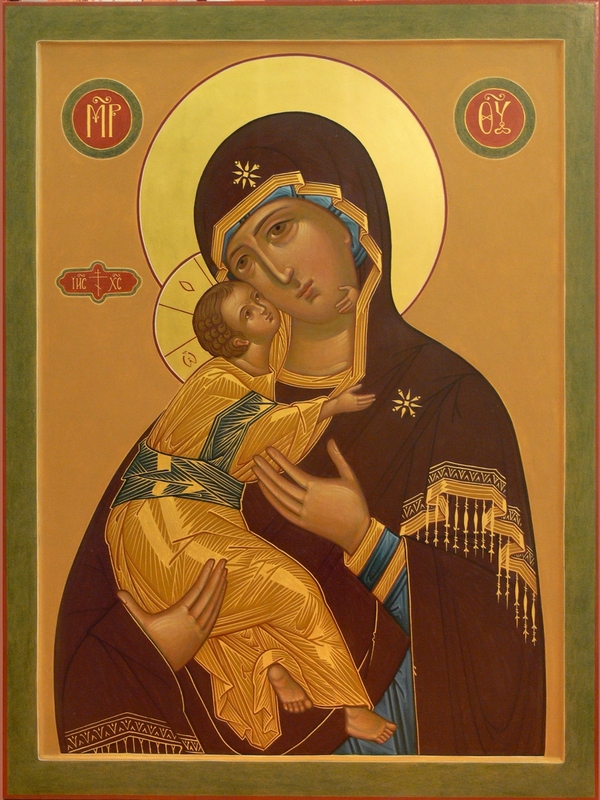
In memory of the miraculous deliverance of Russia from the invasion of Tamerlane, on the day of the meeting in Moscow of the Vladimir Icon of the Mother of God on August 26 / September 8, a solemn church holiday of the Presentation of this icon was established, and a temple was erected at the very place of the meeting, around which the Sretensky Monastery was later located.
For the second time, the Mother of God saved Russia from ruin in 1480 (commemorated on June 23 / July 6), when the army of Khan of the Golden Horde Akhmat approached Moscow.
The meeting of the Tatars with the Russian army took place near the Ugra River (the so-called “standing on the Ugra”): the troops stood on different banks and waited for a reason to attack. In the front ranks of the Russian troops they kept the icon of Our Lady of Vladimir, which miraculously put the Horde regiments to flight.
The third celebration of the Mother of God of Vladimir (May 21 / June 3) commemorates the deliverance of Moscow from the defeat by Makhmet Giray, Khan of Kazan, who in 1521 reached the limits of Moscow and began to burn her settlements, but suddenly retreated from the capital without harming her.
Before the Vladimir Icon of the Mother of God, many important events of Russian church history took place: the election and installation of St. Jonah - Primate of the Autocephalous Russian Church (1448), St. Job - the first Patriarch of Moscow and All Russia (1589), His Holiness Patriarch Tikhon (1917 .), as well as in all centuries, oaths of allegiance to the Motherland were taken before it, prayers were performed before military campaigns.
Iconography of the Mother of God of Vladimir
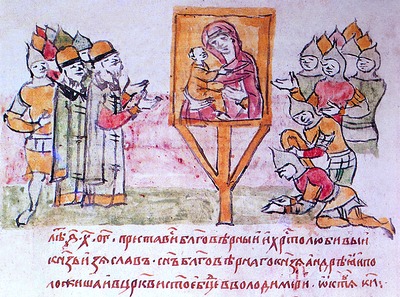
The icon of the Mother of God of Vladimir belongs to the “Carssing” type, also known under the epithets “Eleusa” (ελεουσα - “Merciful”), “Tenderness”, “Glycofilus” (γλυκυφιλουσα - “Sweet Kiss”). This is the most lyrical of all types of iconography of the Virgin, revealing the intimate side of the communication of the Virgin Mary with her Son. The image of the Mother of God caressing the Infant, his deep humanity turned out to be especially close to Russian painting.
The iconographic scheme includes two figures - the Mother of God and the Infant Christ, clinging their faces to each other. Mary's head is bowed to the Son, and He embraces the Mother by the neck with his hand. A distinctive feature of the Vladimir icon from other icons of the Tenderness type: the left leg of the Christ Child is bent in such a way that the sole of the foot, the “heel”, is visible.
In this touching composition, in addition to its direct meaning, there is a deep theological idea: the Mother of God, caressing the Son, appears as a symbol of the soul, which is in close communion with God. In addition, the embraces of Mary and the Son suggest the future sufferings of the Savior on the Cross; in the caressing of the Infant by the Mother, his future mourning is foreseen.
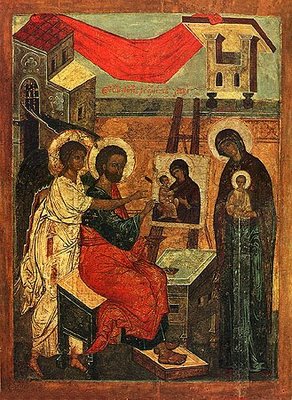 The work is permeated with a completely obvious sacrificial symbolism. From a theological point of view, its content can be reduced to three main themes: "the incarnation, the predestination of the Infant to sacrifice and the unity in love of Mary the Church with Christ the High Priest." This interpretation of the Mother of God Caressing is confirmed by the image on the back of the icon of the throne with the symbols of the Passion. Here in the 15th century they painted an image of the throne (etimasia - “the throne prepared”), covered with an altar cover, the Gospel with the Holy Spirit in the form of a dove, nails, a crown of thorns, behind the throne - the Calvary cross, a spear and a cane with a sponge, below - the floor of the altar flooring. The theological interpretation of etimasia is based on Holy Scripture and the writings of the Church Fathers. Etimasia symbolizes Christ's resurrection and His judgment on the living and the dead, and the instruments of His torment - the sacrifice made for the atonement of the sins of mankind. The juxtaposition of Mary caressing the Child and the turnover with the throne clearly expressed the sacrificial symbolism.
The work is permeated with a completely obvious sacrificial symbolism. From a theological point of view, its content can be reduced to three main themes: "the incarnation, the predestination of the Infant to sacrifice and the unity in love of Mary the Church with Christ the High Priest." This interpretation of the Mother of God Caressing is confirmed by the image on the back of the icon of the throne with the symbols of the Passion. Here in the 15th century they painted an image of the throne (etimasia - “the throne prepared”), covered with an altar cover, the Gospel with the Holy Spirit in the form of a dove, nails, a crown of thorns, behind the throne - the Calvary cross, a spear and a cane with a sponge, below - the floor of the altar flooring. The theological interpretation of etimasia is based on Holy Scripture and the writings of the Church Fathers. Etimasia symbolizes Christ's resurrection and His judgment on the living and the dead, and the instruments of His torment - the sacrifice made for the atonement of the sins of mankind. The juxtaposition of Mary caressing the Child and the turnover with the throne clearly expressed the sacrificial symbolism.
Arguments have been put forward in favor of the fact that the icon was two-sided from the very beginning: this is evidenced by the same forms of the ark and the husks of both sides. In the Byzantine tradition, images of the cross on the back of the Virgin icons were not uncommon. Starting from the 12th century, the time of the creation of the “Vladimir Mother of God”, in Byzantine murals, etimasia was often placed in the altar as an image behind the altar, visually revealing the sacrificial meaning of the Eucharist taking place here on the throne. This suggests the possible location of the icon in antiquity. For example, in the Vyshgorod monastery church, it could be placed in the altar as a double-sided altar icon. The text of the Legend contains information about the use of the Vladimir icon as an altar and remote icon that moved in the church.
The luxurious attire of the Vladimir Icon of the Mother of God, which she had, according to the chronicles, also does not testify in favor of the possibility of its location in the altar barrier in the 12th century: decorate yu, put in the c (e) rqui of yours in Volodimer. But many of the portable icons were later strengthened precisely in iconostases, like the Vladimir icon in the Assumption Cathedral in Moscow, originally placed to the right of the royal gates:<икону>to the blessed temple of her glorious Assumption, which is the great Cathedral and Apostolic Church of the Russian Metropolis, and put it in a kiot on the right land, where it still stands visible and worshiped by all ”(See: Book of Power. M., 1775. Part 1 pp. 552).
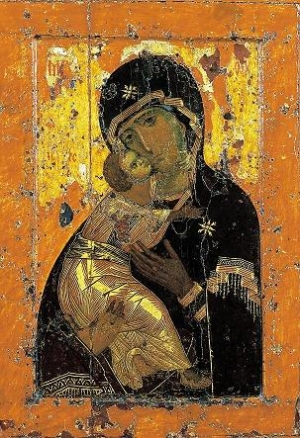 There is an opinion that the "Vladimir Mother of God" was one of the lists of the icon of the Mother of God "Carssing" from the Blachernae Basilica, that is, a list from the famous ancient miraculous icon. In the Tale of the Miracles of the Icon of the Mother of God of Vladimir, she is likened to the Ark of the Covenant, like the Virgin Mary herself, as well as her Robe, which was kept in the rotode of Agia Soros in Blachernae. The Legend also speaks of healings that are performed mainly thanks to the water from the ablutions of the Vladimir icon: they drink this water, wash the sick with it, and send it to other cities in sealed vessels to heal the sick. This miraculous work of waters from the washing of the Vladimir icon, emphasized in the Legend, could also be rooted in the rituals of the Blachernae sanctuary, the most important part of which was the chapel of the spring dedicated to the Mother of God. Constantine Porphyrogenitus described the custom of bathing in a font in front of a marble relief of the Mother of God, from whose hands water flowed.
There is an opinion that the "Vladimir Mother of God" was one of the lists of the icon of the Mother of God "Carssing" from the Blachernae Basilica, that is, a list from the famous ancient miraculous icon. In the Tale of the Miracles of the Icon of the Mother of God of Vladimir, she is likened to the Ark of the Covenant, like the Virgin Mary herself, as well as her Robe, which was kept in the rotode of Agia Soros in Blachernae. The Legend also speaks of healings that are performed mainly thanks to the water from the ablutions of the Vladimir icon: they drink this water, wash the sick with it, and send it to other cities in sealed vessels to heal the sick. This miraculous work of waters from the washing of the Vladimir icon, emphasized in the Legend, could also be rooted in the rituals of the Blachernae sanctuary, the most important part of which was the chapel of the spring dedicated to the Mother of God. Constantine Porphyrogenitus described the custom of bathing in a font in front of a marble relief of the Mother of God, from whose hands water flowed.
In addition, this opinion is supported by the fact that under Prince Andrei Bogolyubsky in his Vladimir principality, the cult of the Mother of God, associated with the Blachernae shrines, received special development. For example, on the Golden Gates of the city of Vladimir, the prince erected the Church of the Deposition of the Robe of the Mother of God, directly dedicating it to the relics of the Blachernae Church.
Style of the Vladimir Icon of the Mother of God
The time of writing the Vladimir Icon of the Mother of God, XII century, refers to the so-called Komnenos' revival (1057-1185). This period in Byzantine art is characterized by the extreme dematerialization of painting, carried out by drawing faces, clothes with numerous lines, whitewash engines, sometimes whimsically, ornamentally lying on the image.
In the icon we are considering, the most ancient painting of the 12th century includes the faces of the Mother and the Child, part of the blue cap and the border of the maforium with a gold assist, as well as part of the ocher, with a gold assist tunic of the Infant with a sleeve up to the elbow and a transparent edge of the shirt visible from under it, a brush left and part of the right hand of the Infant, as well as the remains of a golden background. These few surviving fragments are a high example of the Constantinopolitan school of painting of the Komnenos period. There is no deliberate graphic character characteristic of the time; on the contrary, the line in this image is nowhere opposed to volume. The main means of artistic expression is built on "the combination of insensible fluids, giving the surface the impression of miraculousness, with a geometrically clean, visibly built line." “The letter of the personal is one of the most perfect examples of “Komnin's floats”, combining multi-layered successive modeling with the absolute indistinguishability of the brushstroke. The layers of painting are loose, very transparent; the main thing is in their relationship to each other, in the translucence of the lower ones through the upper ones.<…>A complex and transparent system of the correlation of tones - greenish sankire, ocher, shadows and highlights - leads to a specific effect of scattered, flickering light.
Among the Byzantine icons of the Komnenos period, the Vladimir Mother of God is also distinguished by the deep penetration into the realm of the human soul, its hidden secret sufferings, characteristic of the best works of this time. The heads of Mother and Son pressed against each other. The Mother of God knows that Her Son is doomed to suffer for the sake of people, and sorrow lurks in Her dark, thoughtful eyes.
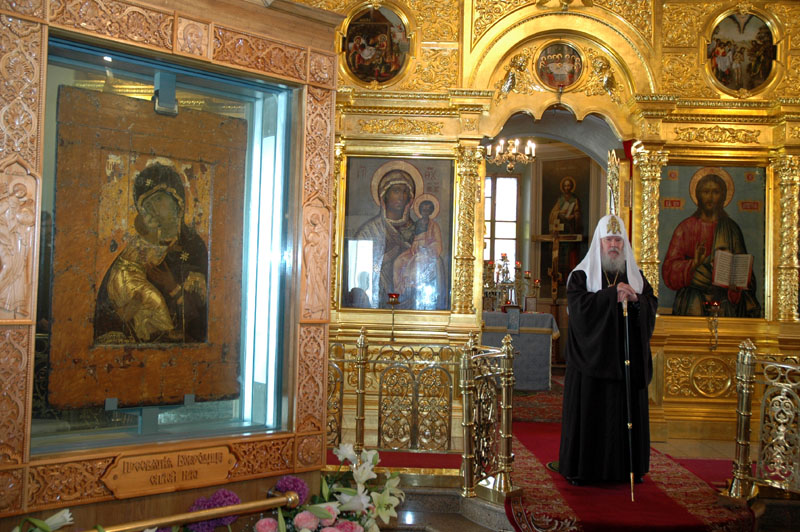
The skill with which the painter was able to convey a subtle spiritual state, most likely, served as the origin of the legend about the writing of the image by the Evangelist Luke. It should be recalled that the painting of the early Christian period - the time when the famous Evangelist-icon painter lived, was the flesh of the flesh of the art of late antiquity, with its sensual, "vivid" nature. But in comparison with the icons of the early period, the image of the Vladimir Mother of God bears the stamp of the highest "spiritual culture", which could only be the fruit of centuries-old Christian thoughts about the coming of the Lord to earth, the humility of His Most Pure Mother and the path they have traveled of self-denial and sacrificial love.
Honored miraculous lists with icons of the Vladimir Mother of God
Over the centuries, many lists have been written from the Vladimir Icon of the Most Holy Theotokos. Some of them became famous for miracles and received special names depending on the place of origin. It:
Vladimir - Volokolamsk icon (commemorated Mr. 3 / 16), which was the contribution of Malyuta Skuratov to the Joseph-Volokolamsk monastery. Now it is in the collection of the Andrei Rublev Central Museum of Ancient Russian Culture and Art.
Vladimirskaya - Seligerskaya (memory D. 7/20), brought to Seliger by Nil Stolbensky in the 16th century.
Vladimirskaya - Zaonikievsky (memory M. 21. / In.3; In. 23 / Il.6, from the Zaonikievsky monastery) 1588.
Vladimir - Orange (memory M. 21 / John 3) 1634.
Vladimir - Krasnogorsk (Chernogorsk) (memory M. 21 / In. 3). 1603.
Vladimir - Rostov (commemorates Av. 15/28) 12th century.
Troparion to the Icon of the Mother of God of Vladimir, Tone 4
Today, the most glorious city of Moscow flaunts brightly, / like the dawn of the sun, O Lady, Your miraculous icon, / to her now, flowing and praying to You, we cry out to you: / oh, wonderful Lady Theotokos, / pray from you to our incarnate God, / may deliver the city this and all the cities and countries of Christianity are unharmed from all the slander of the enemy, // and our souls will be saved, like Mercy.
Kontakion to the Vladimir Icon of the Mother of God, Tone 8
To the chosen Voivode, victorious, / as if they were delivered from the evil ones by the coming of Your honest image, / Lady of the Mother of God, / we lightly create the feast of Your meeting and usually call Thee: / Rejoice, Bride Unbrideed.
Prayer to the Vladimir Icon of the Mother of God
O All-Merciful Lady Theotokos, Heavenly Queen, Omnipotent Intercessor, our shameless Hope! Thanking Thee for all the great blessings, in the generations of the Russian people from You who were, before Your most pure image, we pray to Thee: save this city (or: this whole, or: this holy monastery) and Your coming servants and all the Russian land from gladness, destruction , land of shaking, flood, fire, sword, invasion of foreigners and internecine warfare. Save and save, Madam, our Great Lord and Father Kirill, His Holiness Patriarch of Moscow and All Russia, and Our Lord (name of the rivers), His Grace Bishop (or: Archbishop, or: Metropolitan) (title), and all His Grace metropolitans, archbishops and Orthodox bishops. Give them good governance of the Russian Church, keep the faithful sheep of Christ indestructible. Remember, Lady, and the entire priestly and monastic rank, warm their hearts with zeal for Bose and, worthy of your title, strengthen each and every one. Save, Lady, and have mercy on all Your servants and grant us the path of the earthly field without blemish. Confirm us in the faith of Christ and in zeal for the Orthodox Church, put into our hearts the spirit of the fear of God, the spirit of piety, the spirit of humility, give us patience in adversity, abstinence in prosperity, love for our neighbors, forgiveness for the enemy, prosperity in good deeds. Deliver us from every temptation and from petrified insensibility, on the terrible day of Judgment, vouchsafe us with Your intercession to stand at the right hand of Your Son, Christ our God. He deserves all glory, honor and worship with the Father and the Holy Spirit, now and forever, and forever and ever. Amen.
______________________________________________________________________
These long and numerous movements of the icon in space are poetically interpreted in the text of the Tale of the Miracles of the Vladimir Icon of the Mother of God, which was first found by V.O. Klyuchevsky in Milyutin's Chetia-Minei, and published according to the list of the collection of the Synodal Library No. 556 (Klyuchevsky V.O. Legends about the miracles of the Vladimir Icon of the Mother of God. - St. Petersburg, 1878). In this ancient description, they are likened to the path that the solar luminary travels: “When God created the sun, he did not set it to shine in one place, but, going around the whole Universe, it illuminates with rays, so this image of our Most Holy Lady Theotokos and Ever-Virgin Mary is not on one place… but, bypassing all countries and the whole world, enlightens…”.
Etingof O.E. To the early history of the icon "Our Lady of Vladimir" and the tradition of the Blachernae cult of the Theotokos in Russia in the 11th-13th centuries. // Image of the Mother of God. Essays on Byzantine iconography of the 11th-13th centuries. - M .: "Progress-Tradition", 2000, p. 139.
Ibid, p. 137. In addition, N.V. Kvilidze published a painting by the deacon of the Church of the Trinity in Vyazemy at the end of the 16th century, where on the south wall there is a liturgy in the temple with an altar, behind which is the icon of Our Lady of Vladimir (N.V. Kvilidze State Institute of Art Studies, April 1997
Etingof O.E. To the early history of the icon "Our Lady of Vladimir" ...
. Throughout its history, it was recorded at least four times: in the first half of the 13th century, at the beginning of the 15th century, in 1521, during alterations in the Assumption Cathedral of the Moscow Kremlin, and before the coronation of Nicholas II in 1895-1896 by restorers O S. Chirikov and M. D. Dikarev. In addition, small repairs were carried out in 1567 (in the Miracle Monastery by Metropolitan Athanasius), in the 18th and 19th centuries ..
Kolpakova G.S. Art of Byzantium. early and middle periods. - St. Petersburg: Publishing House "Azbuka-Klassika", 2004, p. 407.
Ibid, p. 407-408.
You have read the article. You may also be interested.










